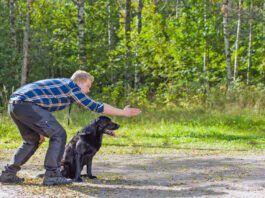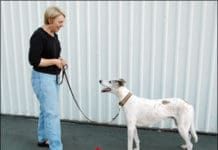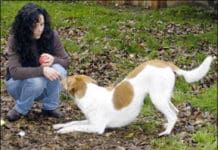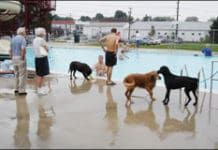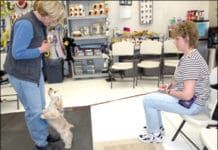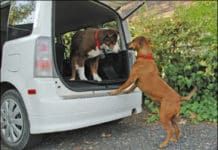Dog Trainers Use of Generalizing a Behavior
But he does it at home!” Usually uttered in a plaintive wail, this common dog owner complaint is often heard in dog training classes, among other places. When one of my students says this, I reassure them that I believe their dog probably does perform the behavior in question with a high degree of reliability in the comfort of his own home. The fact that he won’t do it in class is usually a generalization issue; the owner has only practiced the behavior with her dog at home. He doesn’t know he’s supposed to do it other places. According to authors Mary Burch, PhD, and Jon Bailey, PhD, in their excellent book, How Dogs Learn, “Generalization occurs when behaviors are seen in contexts other than those in which they were originally trained.” Simply stated, this means practicing with your dog in different places, at different times of the day, under different conditions, in the presence of different people, dogs, and a variety of other distractions.
Nocturnal Dogs
and matching leash all get softer with time and laundering. I like the extra large D-ring for snapping the leash onto.
Tug O’ War is a Fun Game to Play With Your Dog
Contrary to conventional wisdom in some dog training circles, tug is a great game to play with most dogs - as long as you and your canine pal play by the rules. Lots of my clients have dogs with aggressive, reactive, and other stress-related behaviors. One of the best ways to help reduce stress is to increase exercise. Tug is great exercise. I'm constantly encouraging my clients to play tug with their dogs. Inevitably when I suggest it I get a puzzled look and a tentative protest that "some trainer" told them playing tug would make their dog dominant and aggressive. I sure wish I could meet that pervasive "some trainer" some day and convince him/her otherwise. It just isn't so. Tug has a lot going for it besides just being good exercise. Most dogs love to tug. Of course, the caveat is that you play tug properly - with rules, which I'll discuss in a minute. Here are some of the many other reasons this game ranks high on my list of approved activities.
Teaching Your Dog to “Leave It” On Cue
mark the desired behavior with the click of a clicker (or the word "Yes!") and feed him a different treat.üPractice "Leave it!" with everything your dog likes in real life: food
Training Your Dog with Rewarding Treats and Praise
Why should training be fun for the dog? Briefest possible answer? “It’s the law.” How animals learn is the most-studied phenomenon in the history of psychology and is up there with gravity in terms of its lawfulness. One of the big ticket principles is that anything one tries to teach a new learner (such as a beginner dog) will get stronger in direct proportion to how many times it is rewarded. And (of perhaps even greater interest) every time the new learner does the behavior and is not rewarded (as in, say, “drilling” the same behavior over and over again) the behavior gets weaker. (Not just “doesn’t get stronger” – gets weaker.) In other words, it’s better to do nothing at all than to drill without rewards.
Keeping Dog Training Fun and Playful
Dogs are one of the rare species of animals who play throughout their lifetimes; perhaps it's one of the reasons we have such strong bonds with dogs, because we too play as grown ups. Humans and canines appear to be what scientists call neotenous": as adults
Solutions for a Dog Who Digs the Yard
The perfect storm, canine edition: Combine one dog who is accustomed to and prefers spending time outdoors; a spate of hot, dry weather; a lush, productive garden full of herbs and tomato plants growing in raised boxes full of expensive, loamy soil and moistened three times daily by an automatic drip system. What do you get? Holes dug in the garden and an irate husband! Our new dog, Otto, nearly made himself quite unwelcome on his second day in our home. Every time I turned around, I'd find him digging in any place we'd recently watered, including the lawn, a flowerbed in front of the house, underneath a gorgeous hydrangea bush that's already hard-pressed to survive our hot summers, and, most seriously, the vegetable beds in back. Can't you train this dog not to dig?" my husband implored. But this wasn't a training issue; I've been trained enough by Pat Miller and our other contributing trainer/writers to recognize a management situation when I see it!"
Positive Dog Training Styles
you'll find that your training really slows down . . . and it's easy to blame the dog for this
Fun Dog Activities
which raises funds for area shelters.
Train Your Dog to Greet People
Recently, I switched the group class format at my Peaceable Paws Training Center to Levels." Instead of a progressive curriculum with new exercises introduced each week
Proper Dog-to-Dog Introductions in the Home
You're contemplating the addition of another canine family member to your pack. You've thought it through and are convinced that it's the right time. However, if you already have dogs in your home, you'll need to prepare for the potentially stressful process known as new dog introduction." There are a number of factors to keep in mind that can increase the likelihood of a positive outcome when introducing a new dog into your home. A peaceful first introduction sets the stage for long term relationships. The more heavily you can weigh the odds in your favor for that first encounter
Training An Older Dog
You've no doubt heard the adage, You can't teach an old dog new tricks." If you have an older dog






